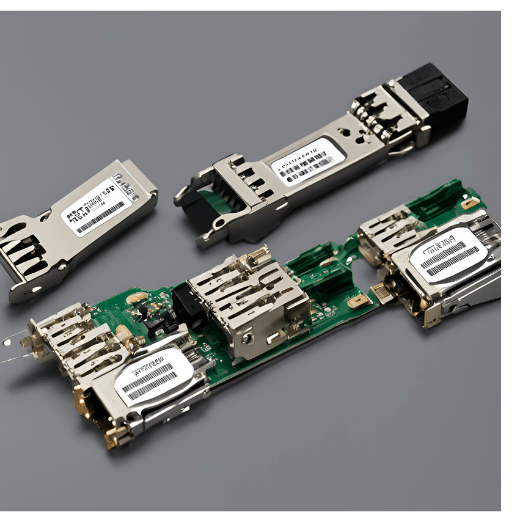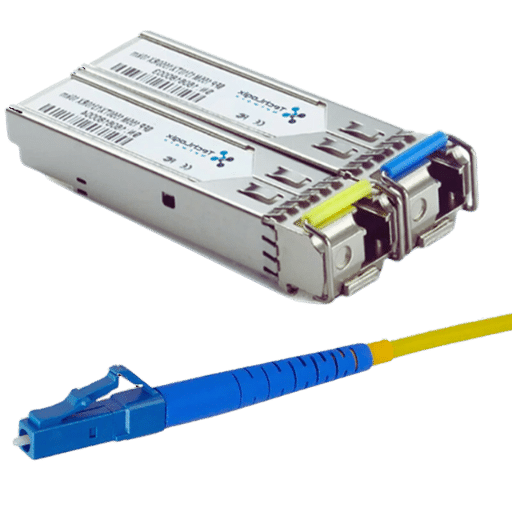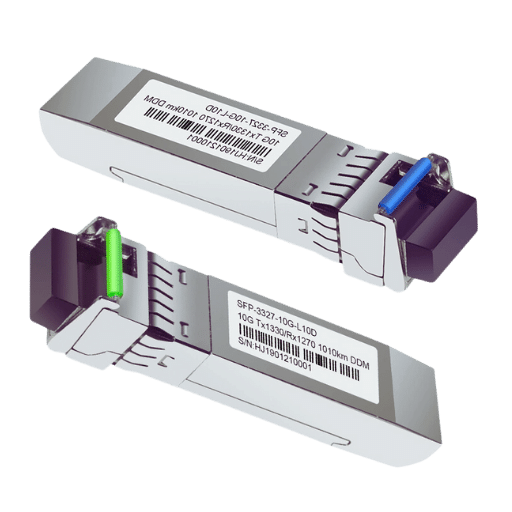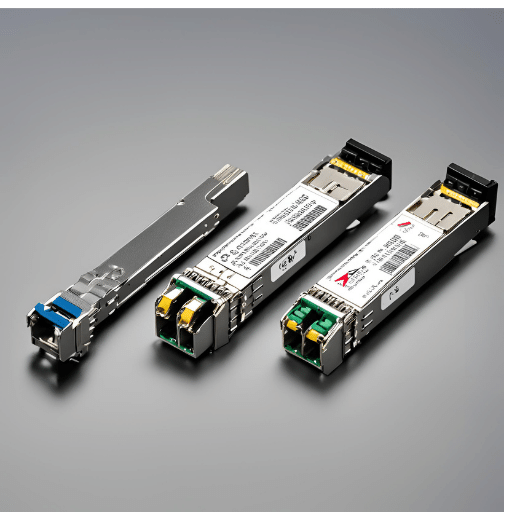Fiber SFP modules are essential to modern networking systems as they allow for faster and more reliable data transfer through fiber optic cables. These universal devices are meant to be easily inserted into network devices like switches and routers, thus facilitating seamless connections between different network portions. The main difference among the SFP modules is their classification according to data rate, transmission distance, and optical fiber type: single mode (SMF) or multimode (MMF).
Understanding operational parameters, compatibility, and specific needs of the networking environment is necessary to realize the full potential of Fiber SFP modules. For example, long-distance transmissions usually use single-mode fibers, which offer high reach at a higher cost than multi-mode fibers suited for shorter distances. On top of that, wavelength compatibility and selection between duplex or simplex fiber configurations are important considerations that directly affect the performance and productivity offered by a network layout.
Moreover, tech-savvy professionals who want to enhance their computerized communication with Fiber SFP modules must also stay up-to-date with state-of-the-art technologies such as DWDM (Dense Wavelength Division Multiplexing) SFPs, which enable sending multiple signals over one same fiber thus considerably increasing bandwidth without needing additional cabling infrastructure.

Compact, hot-swap networking device that accommodates SFP (Small Form-factor Pluggable) transceiver serves for connecting switches and routers such as telecommunications and data communications equipment to fiber optic or copper networking cables. It is used for communication interfaces; it changes electrical signals to optical signals and vice versa. SFP transceivers use either light to transmit data through fiber optic wires for long-distance and high-speed communication or electric signals to transmit data over short distances using copper cables. Ethernet, SONET, Fibre Channel, etc., are some of the communication standards they support. SFP module design allows for easy installation of network hardware that can be removed anytime from a network system while upgrading it or repairing it without interrupting normal operation, resulting in scalable, adaptable networks.
In the world of fiber optic communication, being able to differentiate between single-mode (SMF) and multi-mode (MMF) fiber optics is important in choosing the right SFP module for your network infrastructure. Here’s a detailed comparison:
Understanding these differences is crucial in selecting the right type of SFP module and fiber cabling for your specific network requirements, ensuring optimal performance and scalability of your communication infrastructure.
The operational capacity and application suitability of Small Form-factor Pluggable (SFP) modules rely on their wavelengths, including 850nm,1310nm, etc. The multi-mode fiber (MMF) based 850 nm wavelength supports high-speed data transmission across short distances of typically data centers or intra-building communications. This means that these organization’s systems can be made more cheaply.
On the other hand, the 1310 nm wavelength is commonly used in single-mode fiber (SMF) systems because it offers a combination of performance and distance. At about three times the length of 850nm without signal amplification per kilometer, this wavelength is suited for applications like Metropolitan Area Network (MAN) and inter-data center connections over long distances.
Beyond 1310 nm, there are longer-range transmission scenarios that require very little signal degradation, like the L-band, S-band, and even 1550-nm wavelengths. To achieve this, however, long-range transmissions must be provided at a low cost so as to make telecommunications networks spanning hundreds of kilometers possible. Since they are expensive due to complex technology requirements, these longer wavelengths have been utilized in global communication networks where they serve as backbones for carrier network transmissions.
Knowing how far each wavelength goes and when it can work well ensures that network architects or planners have all the information needed to decide wisely about scaling up their networking infrastructure for efficiency and better performance.

Choosing the right type of Small Form-factor Pluggable (SFP) modules is a matter of considering factors such as distance, data rate, and cost. The Single-mode Fibre (SMF) has a smaller core diameter and is meant for long-range communication that can go well beyond kilometers with little signal loss, hence it suits applications requiring high bandwidth over long distances like intercity or cross-data center connectivity. On the other hand, Multi-Mode Fiber (MMF) is larger in core size and, therefore, designed to cover short distances, generally up to 550 meters, for data communication, meaning it is ideal for in-building or campus networks where faster data rates are required within relatively small geographical spans. Due to this trade-off on reach, performance, and investment, the decision should depend on what each scope of application aims to achieve.
The compatibility between SFP modules and network equipment like switches and routers is essential for making a reliable and efficient network infrastructure. In order to facilitate this, Cisco, Ubiquiti among others have their own versions of SFP modules that are compatible with their hardware. Nonetheless, different brands may be subjected to different levels of interoperability.
By observing these parameters network architects can be able to choose SFP modules that fit technically but still maintain the performance and reliability standards expected of them in their particular networking environment.
LC Connectors in Fiber Optic Communication
The LC connector is a critical part of fiber optic communication for many reasons. First, the smallness of its design allows it to be used in environments where networks are densely populated, enabling a larger number of fibers to be installed within limited space such as data centers and telecommunication racks. Secondly, even with its small form factor, the LC connector ensures high precision and minimal signal loss, which is crucial for maintaining data integrity over long distances. Thirdly, it has a secure locking mechanism that avoids accidental disconnection hence enhancing network reliability.
DDM Role in SFP ModulesNetwork administrators can monitor real-time parameters such as optical power output/input, temperature, laser bias current, and transceiver supply voltage, among others, due to this technology.
Digital Diagnostic Monitoring (DDM), also called Digital Optical Monitoring (DOM), is an embedded feature within Small Form-factor Pluggable (SFP) modules that provides live insights into the performance of fiber optic connections. Network administrators can monitor real-time parameters such as optical power output/input, temperature, laser bias current, and transceiver supply voltage, among others, due to this technology. The significance of DDM lies in its capability to enable proactive network maintenance and troubleshooting. By utilizing diagnostic data, network experts are able to detect and handle matters like signal deterioration or device failure before they cause network downtime, hence significantly improving performance and reliability on the network.

To optimize fiber SFP modules for 1 gigabit and 10 gigabit speeds, one needs to take into account attention to several technical aspects in order to maintain them at the peak within a gigabit network. First of all, there is a need for proper selection of SFP module type depending on whether it is standard SFPs for 1 Gbps networks or SFP+ module designed for higher speeds of 10 Gbps. The choice depends on the required bandwidth, distance, and optical fiber type (single-mode or multi-mode). Secondly, the quality of optical fiber cabling plays a significant role; ensuring minimal signal loss and optimal signal integrity is essential, especially for longer distances where signal degradation can be more pronounced. The use of high-quality cables, appropriate cable management, and bending radius specifications limit physical damage risk as well as signal ability.
Additionally, the network infrastructure must support higher data rates since they are requested by environments needing high-speed data transmission. This includes switches and routers with enough port speeds and throughput capacities. Regular firmware updates and maintenance of the networking equipment ensure compatibility and peak performance with gigabit and ten-gigabit sfp modules.
Finally, utilization of DDM features in SFP modules enables real-time monitoring while it provides an opportunity to adjust performance parameters when necessary. This proactive approach towards monitoring will enable identification issues before they start impacting network performance thus allowing adjustments meant at optimizing data transmission speeds and reliability. A collective implementation of these strategies will greatly enhance efficiency and reliability in fiber networks operating at 1 Gbps/10Gbps speeds.
Ethernet SFP (Small Form-factor Pluggable) transceivers are crucial in advancing network performance, thereby allowing for flexibility and expandability of data communication networks. These small-sized pluggable modules can be changed without turning off the network device and linked to a number of copper networking cables or fiber optic ones, thus making it possible for them to provide speeds that range from 1 Gbps to 10 Gbps and above. With SFP transceivers, one physical media can serve different purposes, hence reducing the expenses on network hardware and making upgrades more convenient. There will be no need to buy an entirely new controller during subsequent changes in service connection.
Moreover, SFP transceivers boost network efficiency through advanced features like Digital Diagnostic Monitoring (DDM) that enable the administrators to look into real-time parameters such as temperature, optical power input/output voltage, and laser bias current, among others that are given by these devices. By doing so, operators can quickly identify any problems before they become major problems, thus ensuring maximum network uptime while keeping the system effective and reliable. To conclude, modern high-performance networks heavily rely on Ethernet SFP transceivers for their proper functioning since they are multipurpose tools; this makes them cost-efficient when it comes to improving the effectiveness of systems for such networks in use today.
In order to maintain the optimal temperature range for SFP transceivers, it is important to ensure that network hardware performs reliably while also improving the lifespan of the equipment. The indicated operating temperature range – normally 0ºC to 70ºC for commercial grade and 40ºC to 85ºC for industrial grade – demonstrates the necessity of efficient heat management in network environments. To achieve and maintain these temperatures, here are some detailed practices:
Through these practices, network administrators can ensure that SFP transceivers work under their optimum temperature range thus maintaining performance levels preventing premature failure due to overheating.

Switching from Copper SFP (Small Form-factor Pluggable) modules to fiber optic transceivers improves bandwidth, distance, and resistance to electromagnetic interference (EMI). Fiber optic technology carries greater data transmission speeds that are crucial for high-bandwidth data centers and telecommunication backbones. Copper cables can only transmit at 1 Gbps or 10 Gbps for a maximum of 100 meters, while fiber optic cables can transmit data over kilometers without significant signal loss. Therefore, it is ideal for long-distance communication. Additionally, unlike copper cables fibre optics do not get affected by EMI which is always a problem in copper cables thus ensuring more reliable data transfer in areas with high levels of interferences.
However, there are financial and infrastructure compatibility issues when one moves from copper to fiber optics. Initially, investment in fiber-optic technology may be higher than that of traditional copper due to the need for specialized tools such as light emitting diodes (LEDs) or laser based transceivers and detectors. On the other hand existing networks must be compatible with the physical conditions of optical wiring or they may have to be reconfigured significantly for them to accommodate it technically.
Optical SFP (Small Form-factor Pluggable) modules play a critical role when it comes to the development and advancement of gigabit fiber networks, which require flexibility and efficiency in telecommunication nowadays. These modules exist with the benefit of allowing for hot swapping, which means they can be interchanged or upgraded easily without necessarily switching off all the network systems, thus maintaining their operation. Optical SFP modules are designed to support different wavelengths and distances, thus making them suitable for various applications ranging from data center short-haul connections to wide area networks (WANs) or metropolitan area networks (MANs) long-haul transmissions.
Moreover, Optical SFP Modules through Wavelength Division Multiplexing (WDM) provide a significant increase in network capacity without adding more fibers. This is done by multiplexing multiple optical carrier signals onto one single optical fiber via several laser light wavelengths (colors). As a result, not only does this capability make scalable Gigabit Ethernet networks, but it also makes them cost-effective by utilizing existing fiber infrastructure to the fullest possible extent. Therefore, incorporating Optical SFP Modules into gigabit Ethernet networks is inevitable if the increasing demand for high-speed communication services is taken into account.
When examining the evolution and implementation of small form-factor pluggable (SFP) modules in gigabit fiber networks, it is necessary to distinguish SFP, SFP+, and QSFP formats for a better appreciation of their capabilities and appropriate uses.
In conclusion, choosing the right type of module – is it SFP, SFP+ or QSFP- depends on few critical parameters like data rate requirements, network scale, distance coverage and cost constraints. By understanding these parameters one can make informed choices that match a specific need of gigabit Ethernet network.

Manufacturer-specific encoding is often the reason why Small Form-factor Pluggable (SFP) modules are incompatible with network devices. These errors cause the networking equipment to fail to identify the module, and this leads to interruptions in operation. Therefore, a tactical approach provides solutions for these problems, which include:
Through doing this, administrators could substantially reduce incompatibility errors as well as guarantee smooth and reliable networks.
Signal loss in small form-factor pluggable (SFP) fiber connections can cripple network performance, requiring a systematic approach to identify and fix the problem. The major steps are:
Following these steps step by step enables network technicians to quickly diagnose and fix such related problems that include signal losses in fiber sfp connections, restoring optimal network functionality.
When the networked devices are not identifying Fiber Small Form-factor Pluggable (SFP) modules, then the following troubleshooting steps should be carried out systematically:
The reasons behind Fiber SFP modules not being recognized can be found out through this step-by-step procedure thereby maintaining high performance as well as dependability of a network.

It is important to take into account the actual durability and applicable technology of fiber Small Form-Factor Pluggable (SFP) modules in assessing their lifecycle and sustainability. Fiber SFP modules of good quality can live for more than 10 years under normal working conditions. Nonetheless, due to fast network technology development and growing data rates, a module may become obsolete before its physical end. It also includes energy efficiency across all stages of the life-cycle, with recent models sometimes produced for low power consumption as per eco-friendly standards. Manufacturers are now adopting measures that increase the lifetime of these components, including reprogramming options aimed at updating firmware to keep them relevant in dynamic networks over time. Hence, the true lifespan of fiber SFP modules in real-world terms depends on both their physical stamina and efficiency in adapting to changing network requirements.
The rapid growth of data traffic and the widening scale of digital transformation require the shift to higher capacity fiber optic cables such as 100 Gigabit Ethernet (100Gbe) and beyond. This change is vital in supporting the exponentially increasing volume of data traffic, cloud computing and high-speed communication needs for modern industries and data centers.
There are several technical factors to consider when transitioning to 100Gbe or more, including using advanced fiber optic modules that enable faster data transfers, such as CFP, CFP2, CFP4, and QSFP28 standards for 100G networking. These modules are designed to be compatible with future network expansions, thereby providing scalability and increased bandwidth. Consequently, integration of coherent optical technology enables wider use case scenarios without compromising on signal quality hence addressing signal degradation challenge over extended fiber links.
These advanced modules need a critical evaluation of the existing network infrastructure which includes considering the quality type(single-mode vs multi-mode)of fibers as well as physical network layout in ways to reduce losses and cross-talks. Proper planning and investment in these technologies allow organizations to make their networks ready for future conditions, ensuring they remain strong, well-functioning, and amendable to changes accompanying developments in the digital era.
The Multi-source Agreement (MSA) standards serve as a crucial part of the fiber Small Form-factor Pluggable (SFP) modules, especially as the industry moves towards higher bandwidth capabilities such as 100Gbe and beyond. These standards are vital for ensuring that different manufacturers’ devices can interoperate with each other, making them compatible and reliable, and can sign against vendor lock-in, thus enhancing competition and innovation in the market. MSA standards govern physical dimensioning, electrical interfaces, and optics specification for SFP modules, which are fundamental to providing seamless integration while maintaining performance consistency across various network environments. Future fibre SFP modules would be compliant with MSA standards by considering these factors, including higher speed data rates, better power consumption, or efficiency while transmitting signals over longer distances. From this angle, therefore, when it comes to deploying next-generation optical fiber technologies, scalability has to go hand in hand with cost-effectiveness so as to allow continuous growth and transformation of digital infrastructure.
Here are three reliable sources that can validate the feasibility of the topic “Unlocking the Potential of Fiber SFP Modules: A Comprehensive Guide”:

A: In communication networks, a Small Form-Factor Pluggable (SFP) module made of fiber optic materials is a small, swappable unit that uses light to send data. It is essential because it allows network devices such as switches and routers to be connected using fiber optic cables capable of delivering more bandwidth, longer distance capabilities, and better network performance than traditional copper cables.
A: To ensure compatibility, consult the product documentation for the recommended or approved SFP modules for that particular switch or router. Most companies, such as Cisco, Juniper, TP-Link, MikroTik, and D-Link, have listed their compatible modules. Additionally, there are many other third-party SFP modules like those offered by FS.com and HP ProCurve compatible products, which are designed to be compliant with different brands. However, confirming their compatibility before making a purchase decision is always wise.
A: Generally speaking, it is not advisable to mix single mode and multimode SFP modules on the same fiber due to the difference in fiber optic cable types. Single-mode fibers use only one light path per long-distance transmission, while multimode fibers use multiple light paths for short-distance transmissions. Nonconvertibility at the interface level can lead to signal loss and errors in data transmission.
A: The maximum achievable distance depends on the type of SFP module used and the type of fiber cabling chosen. For example, 1000Base-SX MMF SFPs can support distances up to 550m, while 1000Base-LX/LH SMF modules can reach up to 10 km. Furthermore, long-haul SFP modules can extend the distance from 40km up to 120km with appropriate single-mode fiber available.
A: Absolutely. SFPs are designed to support hot swapping, so they can be inserted or removed from a switch or media converter without having to power down the device. This feature offers great flexibility and helps reduce downtime while upgrading or fixing networking links.
A: The choice of either a 1G or a 10Gbe SFP module depends on your network’s bandwidth needs, budgetary allocation, and hardware compatibility. On the fastest ethernet or gigabit ethernet networks, a 1G SFP module is sufficient, offering speeds up to 1 Gbps. Conversely, for enterprise-level networks, data centers, and high-speed storage applications, a 10Gbe SFP+ provides more bandwidth of up to 10Gbps. Before upgrading your system, ensure your network equipment specifications support these modules.
A: WDM (Wavelength Division Multiplexing) technology allows light signals at different wavelengths (or frequencies) to be transmitted over the same single-mode fiber. This technology is present in certain types of SFP optical modules, where it enhances the bandwidth by significantly increasing the capacity of data transmission without laying additional fiber. WDM has two principal divisions, CWDM (Coarse Wavelength Division Multiplexing) and DWDM (Dense Wavelength Division Multiplexing), depending on channel spacing and the number of wavelengths employed.
A: Yes, fiber SFP module performance can be affected by environmental factors such as temperature, humidity, and EMI. Most models have specific operating temperature ranges. Commercial grade is typically between -40°C and +85°C, while industrial-grade may range from -40°C to +70°C. High-grade optics are available from –40 °C to +85 °C, covering all commonly used applications. One should always select appropriate heat sinks or other cooling devices to ensure efficient transfer from packet source ICs through the PCB to the SFP modules.